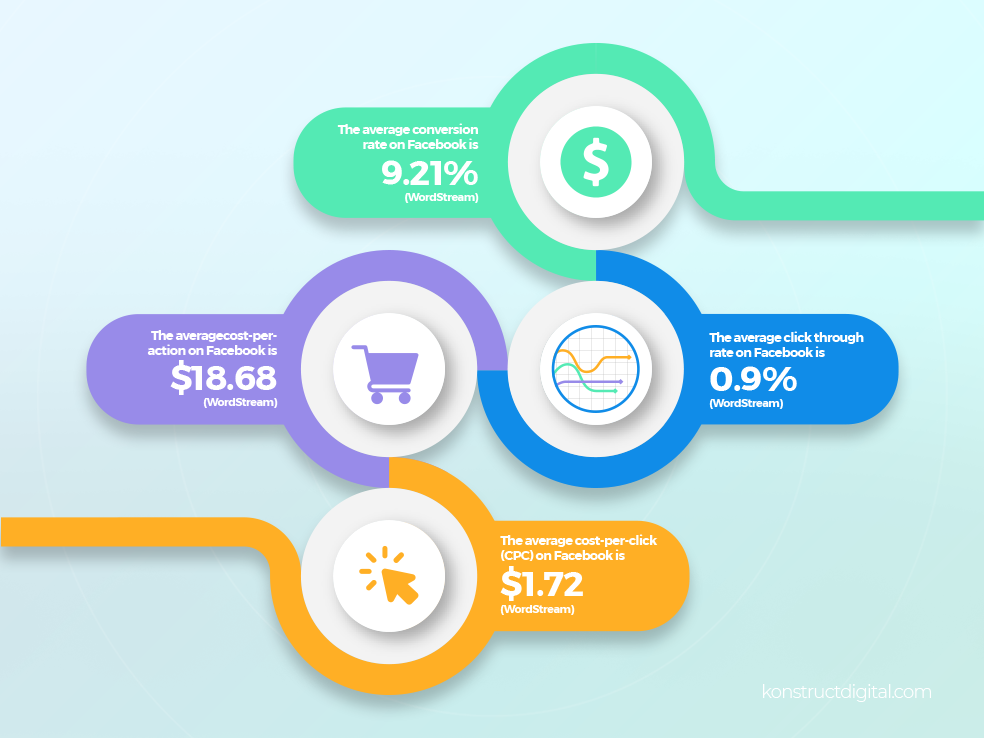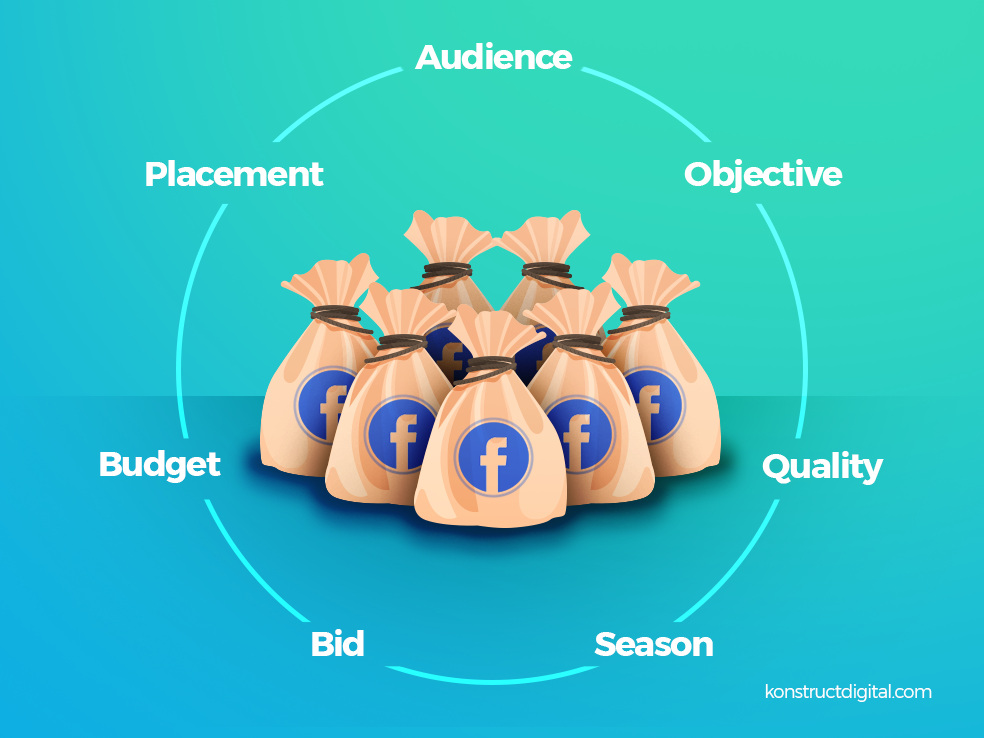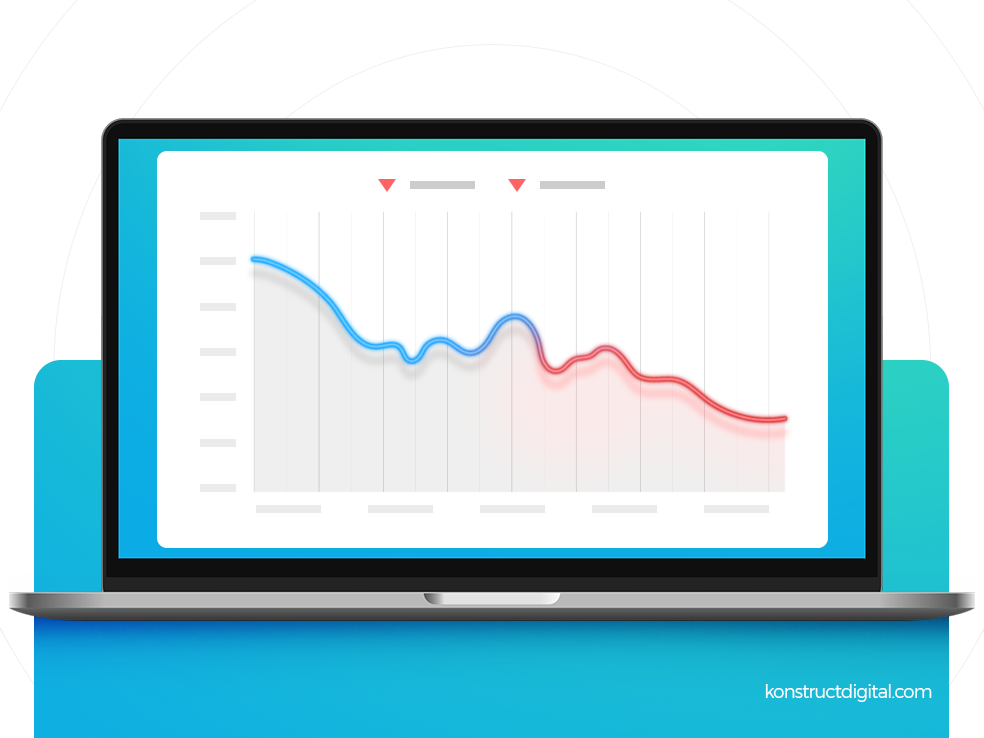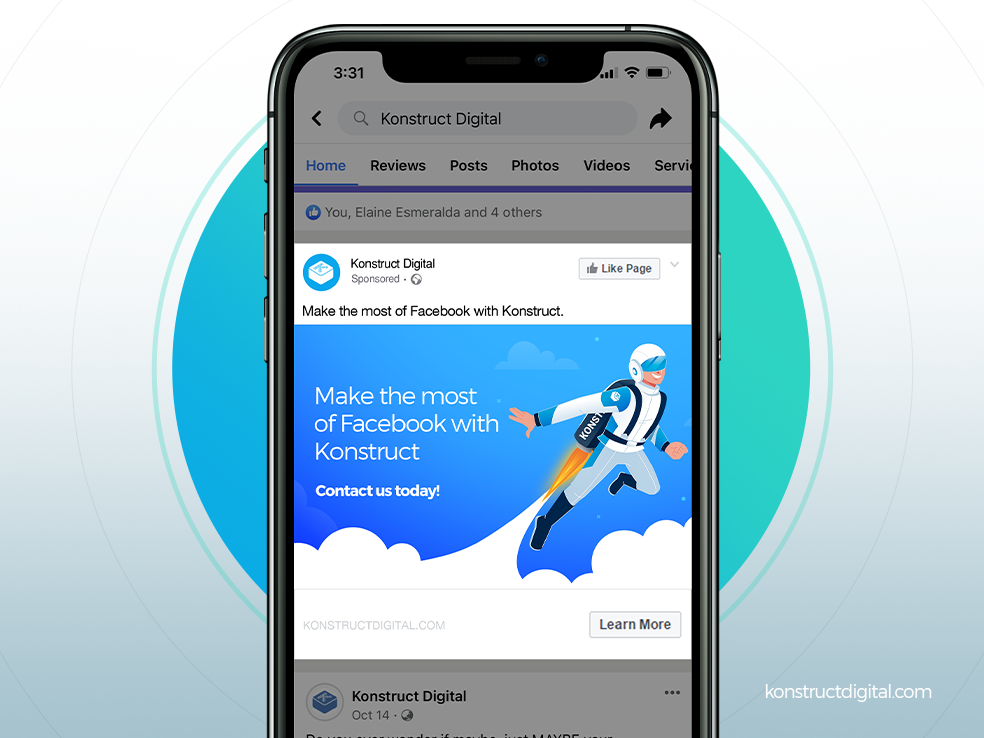Are you considering using Facebook ads, but not sure how much to budget for them?
We understand your dilemma!
Facebook ads are a complex topic, so let us help you understand them and the costs a bit better.
Creating Facebook ads doesn’t have to be frustrating. If you’re stuck trying to figure out how to run Facebook ads at a low cost, you should keep reading.
Creating goal-oriented ads while achieving positive results is possible! Use this article to release your frustration and allow you to see the light at the end of the funnel…get it?
In this article, we’ll break down what determines the cost of a Facebook ad and share tips on how to lower the costs! Who doesn’t love saving money wherever possible?
Why Invest in Facebook Ads
There are many benefits to Facebook advertising, the most important one being the ability to target your desired audience directly. If you know your customers, you can use Facebook advertising to grow your business. Facebook allows you to advertise according to different criteria, including:
- Interests
- Location
- Age
- Behaviour
So…how Much Do Facebook Ads Cost?
The cost of Facebook advertising ranges from approximately $0.40 to $12.00 per click. Now, this depends on many factors, and realistically, it totally depends on what ad you are trying to run.
Before jumping to conclusions that this article will provide precise figures for the cost of every Facebook ad, let’s clarify…
Every ad has a different price depending on various factors and can fluctuate between industries. In other words, an exact price breakdown just isn’t possible.
Facebook Ads by the Numbers

Here are some average numbers to help plan your ad campaigns and ad budget accordingly:
- The average conversion rate on Facebook is 9.21% (WordStream)
- The average cost-per-action on Facebook is $18.68. (WordStream)
- The average click through rate on Facebook is 0.9% (WordStream)
- The average cost-per-click (CPC) on Facebook is $1.72 (WordStream)
7 Key Variables That Determine Facebook Ad Costs

Understanding Facebook advertising costs, it’s now time to explore the factors influencing these prices. While the specific determinants may vary, there are typically seven key variables that have the greatest impact on Facebook ad costs.
1. Audience
The audience for your ads significantly impacts your advertising costs. Your Facebook audience, the group of people that you want to reach with your ad, can be narrowed down to locations, demographics, gender, age, interests and more. By targeting specific groups, you can receive the most out of your ads.
Creating relevant ads for your target audience is necessary, although it may increase the costs depending on who the audience is. For example, if targeting 25-34-year-olds, it’s possible to reach 58.3 million people. Now, you would not run an ad to every single person in your targeted age range (as that is too broad); but you may start there and begin to narrow down your audience. Targeting custom audiences is crucial because your goal extends beyond mere clicks, the goals should also be complete actions taken from Facebook ads, such as purchases.
2. Competition
Competition can influence your Facebook ad costs significantly. This is because the number of competitors you have and their respective budgets can cause fluctuations in your advertising costs, either increasing or decreasing them. On average, if you have a lower level of competition, the less your Facebook ads will cost, and if you have a higher level of competition, the more they will cost.
3. Ad Bid
Bidding strategies are provided through Facebook and will impact the Facebook ad cost. Facebook offers two bid strategies that play a part in determining the costs. These are:
- Manual bidding (cost cap, bid cap or target cost):
This bidding strategy will allow you to determine how much you will spend when advertising. Cost cap and bid cap bidding are available for all campaign types; there are requirements that need to be met to use target cost (minimum ROAS) bidding. These manual bidding options have pros and cons, but it really comes down to your advertising goals.
- Automatic bidding (lowest cost):
This bidding strategy is designed to help you reach the lowest-cost opportunities while aiming to use your entire budget. The lowest-cost bidding is more efficient, and you can see some lower cost per result than with manual bidding, but you do tend to see more fluctuation in Facebook advertising costs with this bidding strategy.
Ad bidding plays a large part in the Facebook Auction, which we cover later in this article. Keep reading to see how to reduce your costs with the auction feature.
4. Ad Objective
There are currently 11 ad objectives that can be placed within three categories: Awareness, Consideration and Conversions. The more valuable your goal is, the more your ad will cost. The amount you spend will depend on the desired action you want your audience to take. For example, if you want your audience to load a landing page, it costs more than if you want the audience to watch a video or engage with an ad. Any objective that leads the consumer to convert or make a purchase (higher revenue and value from the ad) will cost more.
Let’s dive into these three ad objective categories.
Awareness
Choosing awareness simply means generating interest in a product or service. For example, if you are a store and are about to launch a new product or service, you may use the awareness objective to highlight your new products and bring awareness to your store. This will start planting seeds in your audience’s head and get them to begin thinking about your shop.
Consideration
While awareness plants the seeds, consideration gets the plant growing. This objective gets people thinking about your business and makes them want to know more. For example, if your store has compelling content that describes what makes them unique, users will want to learn more.
Conversion
The conversion objective encourages users interested in your business to purchase your product or service. For example, if your store has a sale, you would want to drive more online purchases to the sale items. The conversion would be the best category as it will deliver to more people likely to make that purchase.
5. Ad Placement
Your Facebook advertising costs are also affected by where the ad is placed. With Facebook Ads, you can place ads on Facebook, Whatsapp, and Instagram. Outside of the typical in-feed ad placements, you may see these ads appear in Messenger, Marketplace, stories, Facebook’s right column, Instagram Explore and even on articles and videos.
Ad costs vary with each placement depending on a few factors but primarily come down to:
- available ad space
- how engaged users are with the placement
- how likely it is to drive results
Typically, running ads on Instagram placements is more expensive than Facebook placements. Running an ad to the audience network will be significantly cheaper than running an ad on the Facebook feed.
6. Ad Relevance & Quality
The quality of your ads and how relevant they are to your audience can significantly affect your Facebook ad costs. High-quality and highly relevant ads perform best as Facebook prioritizes better user experiences. Along with relevancy, many factors determine the quality of ads, including:
- Feedback from users: Are they engaging with the ad, or are they scrolling past or even clicking “this isn’t relevant to me”?
- Quality of the ad: Are your headlines and copy engaging, do you have low-quality images or videos being delivered?
- Conversions rate: Are users actually taking the action you want them to take?
Not only do high-quality ranking ads perform better, but they also cost less. If you’re unsure whether or not your ad is high or low-quality, along with the points above, here are some attributes that may signal to Facebook that you have low-quality ads:
- Engagement bait
- Withholding information
- Exaggerated or misleading headlines
Once your ads have been running and collecting data, you can see your quality ranking at your ads level in Business Manager.
7. Season
Seasons can significantly affect Facebook ad costs. When creating a budget, it’s important to think of the lifetime budget. Ad costs typically increase by 100-200% in Q4, and you can see costs starting to creep up in Q3 as well. This is due to the large increase in advertising for Black Friday, Cyber Monday, and Christmas. When creating budgets, take a look at holidays or trends on the horizon to ensure you are spending your budget in the right place, specifically at the right time. If you don’t need to run ads during Q4, consider saving your budget and running more ads during Q1 & Q2.
3 Ways to Lower Facebook Ad Costs

There are many different ways to reduce your Facebook ads costs. Here are three that may benefit you the most.
1. Choose the Best Ad Campaign Type
When you begin creating your Facebook ad campaign, it’s important to consider your goals. If you know your goals, it’s easier to choose the correct ad objective—awareness, consideration, or conversion. Essentially, these three campaign objectives are what you want your ad to accomplish, meaning getting users to click and go to your website or purchase a specific product, for example.
If you choose awareness as your campaign objective, two objectives within it must align with your ad goals:
- Brand awareness – Increases user awareness of your brand.
- Reach – Promotes your ad to as many people as possible.
If you choose consideration as your objective, there are six objectives within it that your company must be trying to achieve:
- Traffic – Sends people from Facebook to your website or the destination of your choice.
- Engagement – Reaches more people that are likely to like, comment, or share. This can also include offers from your page.
- Video Views – Shares relevant videos with people who are most likely to view them.
- App Installs – Directs people to a source where they can download your app.
- Messages – Connects with users via messenger or direct message on Instagram or WhatsApp.
- Lead Generation – Collects information from people that are interested in your project. This includes email addresses or phone numbers.
If you choose conversion as your objective, there are three objectives within it that need to match up with your ultimate Facebook ad goals:
- Conversions – Encourages people to take specific actions, including downloading an app, purchasing items, filling out a form, etc.
- Catalogue Sales – Promotes products from your store’s online inventory.
- Store Traffic – Promotes physical traffic to your store.
As your business grows or innovates, your objectives will likely change or alter to target different actions.
2. Define Your Audience
The more niche or specific your target audience is, the less it will cost you! Although you may reach more people with a broad audience, you may find that you have lower click-through rates and conversion rates. Audience targeting based on their specific demographics or relevant experiences can reduce your costs and provide you with successful ad campaigns. When creating an audience, you want to find the most relevant audience for your brand.
3. Create an Ad Funnel
A Facebook ad funnel is a conversion strategy that can help convert Facebook users into loyal customers. The funnel works in a straightforward yet highly effective way.
- At the top of the funnel (TOFU), we are trying to reach our “cold audience”, this is where you can begin planting that seed in your audience’s brain. We are just looking to get the brand name out to the audience.
- Next, we have the middle of our funnel (MOFU); this is where we would look at remarketing to a “warm audience.” We want this audience to learn more about our brand and some of our offerings. At this step, we want to add some information that the audience may not know yet or some selling points (e.g. free shipping, sustainable, environmentally friendly, etc.) to grab their attention.
- Finally, we have the bottom of the funnel (BOFU). This is where we want our users to complete the desired goal; here, we target our “hot” audience—users who are so close to converting or completing the goal but just need that extra little push.
Ad funnels can look different for every brand and its goals. When creating a brand funnel, you may not use a campaign objective from every category. But, it is more about introducing yourself to your audience and slowly providing them with more information until you feel they have interacted enough with your brand to complete your desired goal. When we talk about desired goals for a campaign, it can look different for every brand and its overall marketing/business goals. For an e-commerce company, the desired BOFU goal will typically be a purchase conversion, whereas, for a new brand, the BOFU goal may be to gain more followers or build an email list.
Ad funnels can help reduce costs to your campaigns by ensuring you reach the right target market at every step of the funnel. This is where ad and audience relevance really come into play. Creating a funnel allows you to find and test your cold audiences using less costly objectives. For example, let’s send an ad to a cold audience using the catalogue sales objective (promoting products from our online shop). We are most likely going to see a way lower conversion rate and a higher cost per conversion than we would if we were targeting someone who has made it all the way through our funnel and has a few products in their shopping cart. Facebook will reward my business with lower costs for delivering my ad to people who are ready to make that purchase.
Facebook Ad Auction
Facebook Ad Auction is basically a hard-working, behind-the-scenes promoter.
Upon creating a Facebook ad, you begin competing with other similar advertisers with the goal to win the battle and have your ad promoted. To see who will win the ad space, Facebook will rank ads chosen for your audience and find the most likely one to maximize value for both advertisers and people. These ads are ranked on three factors:
- Bid – the ad amount you bid.
- Estimated action rates – the likelihood of users completing your desired outcome (click-through rate, conversion rate, view rate, etc.).
- User Value – Ad quality and how relevant your ad is to the target audience .
Once your ad goes into auction, the winning ad is the one that’s ranked with the highest total value. Meaning, your ad will be shown to your target audience rather than your competitor’s ad. Although many different factors play into Facebook Ad Auctions, it’s essential to focus on creating high-quality campaigns to ensure you aren’t spending more money than necessary.
Make the Most of Facebook Ads

Effective budgeting plays a crucial role in shaping the performance of your advertisements. Although having the lowest costs is ideal, spending the lowest amount of money may make your Facebook ad useless. On average, each cost per click costs $1.72, which means that your budget needs to reflect your industry while providing a competitive advantage. Note that this number is an average of all industries, and yours may vary. Budgeting more money for ads can give you more flexibility and higher impression rates.
Overall, Facebook ads are useful to gain more visibility for your brand and boost traffic to your website. Facebook is a great platform to create customizable and effective ads that allow you to gain strong marketing results.
At Konstruct, our PPC Specialists excel in Facebook Ads. If you’re struggling with creating accurate advertisements at a reasonable cost that land every time, contact us. We have helped dozens of businesses with their Facebook ads, and we are ready to help you succeed and stay on budget!
Need help with B2B PPC?
Learn more about Konstruct's B2B PPC Services
More B2B PPC Resources
- Do B2B Google Ads Campaigns Need Siloed Landing Pages?
- The Do’s and Don’ts of B2B LinkedIn Ads
- How to Target Facebook Ads: The Ultimate Guide for Success
- AI Run Amok: Being Deliberate with PPC Automated Bidding Strategies
- Don’t Optimize Your Facebook Ads Too Soon!
- Facebook Ads Tip: The “Engaged Shoppers” Purchase Behaviour
- Google’s Death Blow to Third-Party Cookies: What’s Next?
- A Quick Guide to Managing Google Ads
- 5 Reasons Not to Blow Your B2B Ad Budget Over the Holidays
- A Beginner’s Guide to Native Advertising


